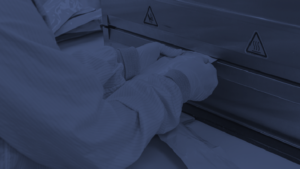Beyond Cleanroom Packaging: Exploring Advanced Sterile Packaging Techniques for Medical Devices
Key Takeaways
- Sterile packaging encompasses techniques beyond cleanroom environments, including terminal sterilization, aseptic packaging, and prevalidated sterile barrier systems.
- Each method offers unique advantages based on the type of device, material compatibility, and regulatory requirements.
- A strategic approach to sterile packaging improves compliance, enhances efficiency, and ensures reliability in the supply chain.
Sterile Packaging: Beyond the Cleanroom
Ensured sterility is essential for medical device manufacturers as it directly affects patient safety, product integrity, and regulatory compliance. While cleanroom packaging is vital for reducing contamination during the assembly and sealing processes, many medical devices require more advanced methods for achieving and maintaining sterile packaging.
Original Equipment Manufacturers (OEMs) must explore various sterilization techniques, packaging materials, and validation processes to maintain sterility throughout the supply chain. Manufacturers risk regulatory delays, product recalls, and compromised device safety without a comprehensive strategy.
This article will examine four key sterile packaging techniques and guide OEMs in selecting the most suitable approach for their devices.

1. Terminal Sterilization: Sterilizing After Packaging
How It Works:
Terminal sterilization involves packaging and exposing the device to methods that eliminate microbial contaminants.
Standard Terminal Sterilization Methods:
- Ethylene Oxide (EtO) Sterilization: Best for devices sensitive to heat and moisture.
- Gamma Radiation: A high-penetration sterilization method ideal for bulk-packaged products.
- Electron Beam (E-Beam) Sterilization: A faster alternative to gamma radiation, though it has a lower penetration depth.
- Steam Sterilization (Autoclaving): Suitable for heat-resistant medical devices and materials.
Why It Matters:
- Ensures sterility without handling the device after packaging.
- Compatible with high-volume production of medical devices.
- Reduces contamination risks compared to manual sterilization processes.
Challenge:
Manufacturers must ensure that packaging materials remain intact after sterilization and not degrade under radiation or heat.
2. Aseptic Packaging: Sterilizing Before Packaging
How It Works:
Devices and packaging materials are sterilized separately and assembled in a controlled, sterile environment before being sealed.
Common Use Cases:
- Biologic-based devices (e.g., drug-device combinations) that degrade under radiation.
- Sensitive implants that cannot withstand harsh sterilization conditions.
- Custom surgical kits require individual sterilization steps before packaging.
Why It Matters:
- Protects heat- and radiation-sensitive devices.
- Maintains sterility throughout the packaging process.
- Eliminates the risks of damage caused by post-packaging sterilization.
Challenge:
Aseptic packaging requires advanced cleanroom environments and detailed operator protocols to ensure they do not compromise sterility during assembly.
3. Prevalidated Sterile Barrier Systems
How It Works:
OEMs use prevalidated sterile packaging solutions that already meet regulatory requirements for sterility, integrity, and durability. Common prevalidated packaging types include:
- Double Sterile Barrier Pouches: An inner sterile barrier is enclosed within a protective outer pouch.
- Rigid Trays with Heat-Sealed Lids: These packaging options safeguard delicate implants from damage.
- Tyvek® and Medical-Grade Paper Wraps: These are breathable materials that allow for compatibility with sterilization processes.
Why It Matters:
- Eliminates the Need for Additional Packaging: Reducing costs and accelerating timelines.
- Speeds Up Regulatory Approvals for New Devices: Efficiently bringing products to market.
- Ensures Consistency Across Multiple Product Lines: Maintains uniformity in packaging standards.
Challenge:
Prevalidated sterile barriers may not be suitable for every device, necessitating careful selection and customization to ensure an appropriate fit.
4. Non-Sterile Packaging for Later Sterilization
How It Works:
Some medical devices are packaged non-sterile and sterilized before use in hospitals, surgical centers, or distribution hubs.
Common Use Cases:
- Surgical instruments and loaner kits are sterilized before each procedure.
- Reusable medical devices that undergo hospital reprocessing.
- Bulk-packaged devices are sterilized before distribution.
Why It Matters:
- Reduces sterilization costs for medical device manufacturers.
- Allows flexibility in device distribution.
- Extends product shelf life before final sterilization.
Challenge:
Even non-sterile packaging must meet barrier protection standards to prevent contamination before sterilization.

Choosing the Right Sterile Packaging Technique
The most suitable sterile packaging method depends on several factors:
- Device Type & Material Compatibility – Is the device compatible with ethylene oxide (EtO), gamma radiation, or steam sterilization?
- Regulatory Requirements – Does the packaging comply with relevant standards such as ISO 11607, FDA regulations, and EU MDR guidelines?
- Supply Chain Strategy – Should sterilization occur before or after packaging?
Medical device manufacturers must find sterility assurance, material integrity, and regulatory compliance to optimize their packaging solutions.
Why Choose Millstone? Your Partner in Sterile Packaging Excellence
Navigating the complexities of sterile packaging requires expertise, validation, and seamless execution. At Millstone Medical, we offer comprehensive sterile packaging solutions, including:
- ISO-certified cleanroom packaging
- Customized prevalidated sterile barrier systems
- Selection of sterilization-compatible materials
- Regulatory-compliant package testing and validation
With Millstone, OEMs gain a trusted partner who understands sterility, compliance, and logistics—all in one place.






